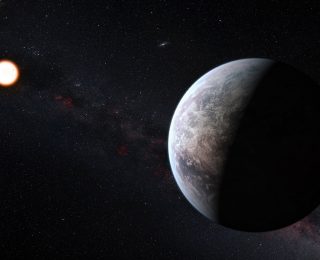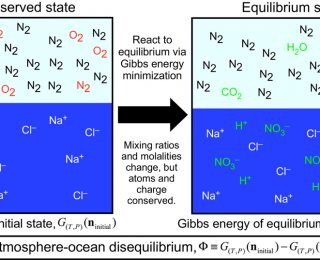
A metal rich exo-Mercury
The planet K2-229 b surprises us with its unique abundances. While its composition is similar to that of Mercury, it is larger and closer to its star.

The planet K2-229 b surprises us with its unique abundances. While its composition is similar to that of Mercury, it is larger and closer to its star.

Investigating which species are out of equilibrium and therefore contributing to the available Gibbs energy, the authors find the disequilibrium in the Archean (about 4 to 2.5 billion years ago) is mostly contributed to the coexistence of CH4, N2, CO2, and liquid water. Methane continuously produced by early life is required to maintain the atmospheric concentration, as otherwise it would have been photodissociated in the upper atmosphere.

When considering a one-dimensional atmosphere, as has been widely used in modeling, we can predict which wavelength will probe deeper into the atmosphere by examining their opacities. Water is one of the main infrared absorbers. Since water absorbs more radiation at 4.5 μm, the opacity at 4.5 μm should be larger than that at 3.6 μm. A larger mass of overlying gas at 3.6 μm is required to achieve the same absorption as at 4.6 μm. Hence, the photosphere (where photons are mostly absorbed and emitted) is deeper at 3.6 μm than at 4.6μm. The radiative cooling operates less efficiently as the pressure increases, hence we know that the day-night temperature contrast should be smaller in the deeper atmospheres. Therefore, one would expect the day-night temperature contrast, represented by the observed phase amplitude, to be also smaller at 3.6 μm than at 4.5 μm. In addition, the phase offset (how the hot spot being shifted) and normalized amplitude should be anti-correlated, with large amplitude phase variations having a small phase offset due to the inefficient heat transport. However, neither of these are observed.

An interesting complication is that the climate is not always the only stable state. Keeping all the conditions unchanged, a close to current climate can be tipped into a snowball state when the solar insolation slightly decreases. This may be easily understood by simply considering the albedo (reflectivity) of the ice. Ice has a much higher albedo (about 0.6) than seawater (about 0.2), so a snowball Earth is able to reflect much more radiation and maintain the temperature below the freezing point. There is a tipping point as the solar insolation decreases, the climate suddenly transitions to global glaciation, referred as the snowball bifurcation. In today’s paper, the authors investigate the snowball bifurcation on habitable tidally-locked planets compared to Earth.

The authors of today’s paper announced an exciting news of finding titanium oxide (TiO) in the atmosphere of a hot Jupiter, WASP-19b. TiO is an inert material in our daily life, for example, people put it in the sunscreen to block ultraviolet (UV) radiation. But as a gas at high temperature (higher than about 2000 K), TiO and VO are extremely absorbent to visible and the near-infrared radiation. They act similarly to the ozone layer on Earth, causing the temperature inversion in the stratosphere, where temperature increases with altitude.